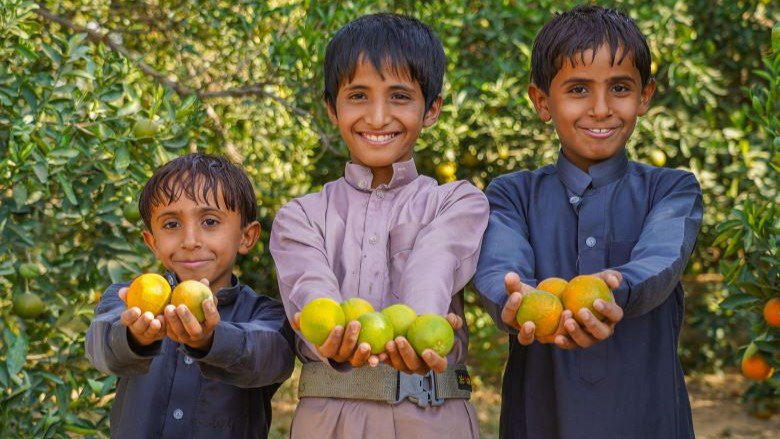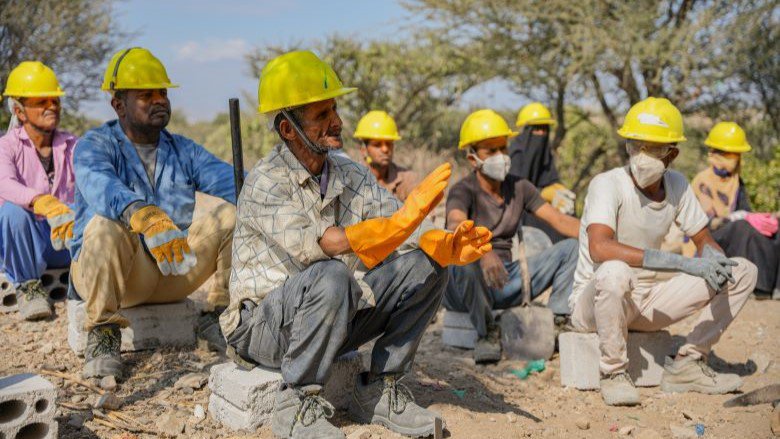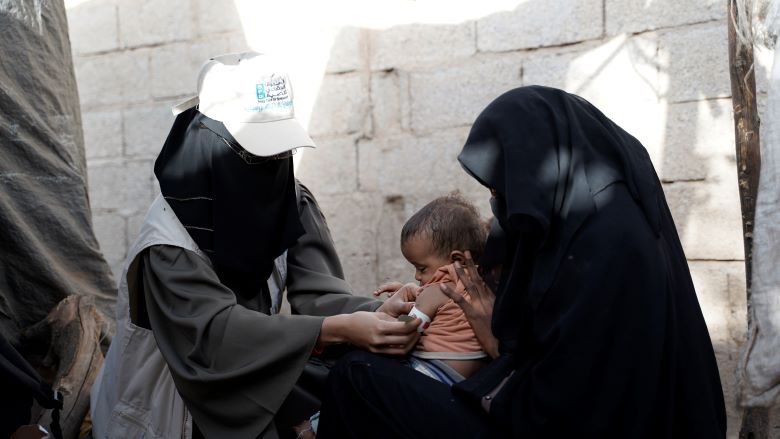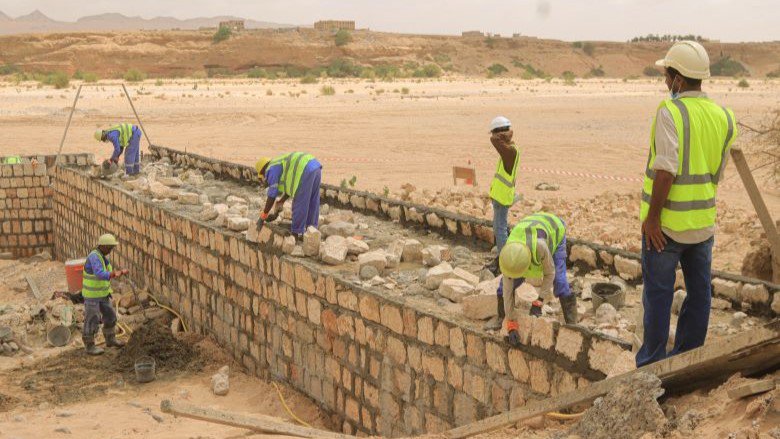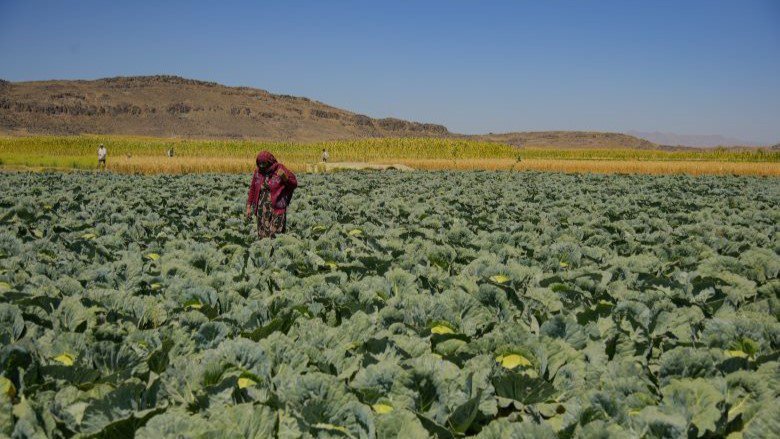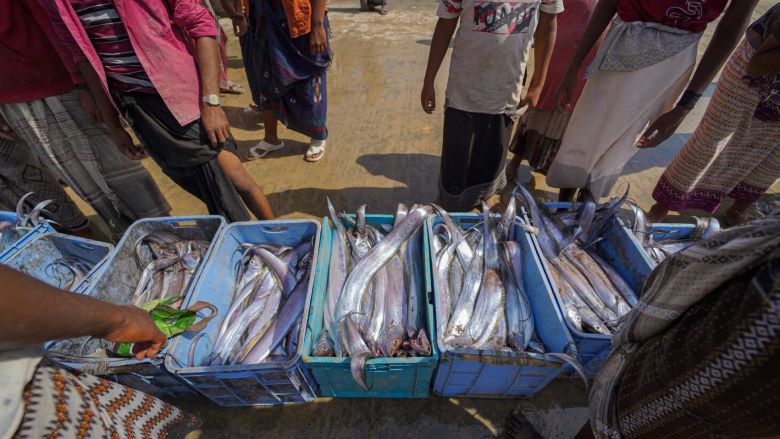Amidst a backdrop of war, soaring inflation, and climate change, food insecurity is the most pressing challenge facing Yemen today. The number of Yemenis who go hungry every day has increased from 10.6 million to 17 million since the war began in 2014.
Addressing food insecurity requires a multi-sectoral response and the World Bank and our partners are approaching this challenge from many angles, including through the creation of temporary jobs, supporting Yemen’s national cash transfer scheme, improving the health of women and children, and ensuring that people have access to safe drinking water.
Access to Cash
To help counteract malnutrition and famine for the most vulnerable, the Emergency Social Protection Enhancement and COVID-19 Response Project (ESPECRP) offers cash transfers, which account for a significant portion of the project funds. Where individuals in at-risk communities can work, the project provides employment opportunities, allowing them to earn a cash wage while also constructing essential community assets. The positive impacts of these cash-for-work (CFW) initiatives are evident in Al-Sujairiah village, in the Dimnat Khadir region of Taiz, where locals earned wages while helping to establish a crucial sewage system.
“The area was polluted, leading to disease outbreaks,” recalls Abdo Al-Faqih, a resident who participated in the project, noting that conditions like cholera, malaria, and diarrhea were rampant. With the assistance of the project, residents devised a solution. “We constructed toilets and a rudimentary sewage system for every household,” Al-Faqih adds.
As well as life-changing infrastructure and a cash wage, “participants received vocational training in carpentry, construction, blacksmithing and plumbing,” adds Abdel-Rahman Abdel-Kareem, a consultant with the Social Fund for Development.
Education on Malnutrition
Alongside cash transfers, the ESPECRP also champions the cash-for-nutrition program, which targets households most at risk of malnutrition, providing urgent cash assistance to mothers. In a country ranked last among 153 nations in the 2020 Global Gender Gap Report by the World Economic Forum, women often eat the least, last, and are most deprived when food is in short supply. Malnutrition disproportionately affects children under five, as well as pregnant and breastfeeding mothers.
Entisar Al-Hujari, a health educator with the cash-for-nutrition program, recalls, “I was deeply concerned when I encountered Ashjan (a young girl of 15 months).” She notes that Ashjan's mother, Zubaida Hassan, 32, was already expecting her eighth child, often with minimal intervals of just four or five months between pregnancies.
Zubaida Hassan describes the severe health struggles her daughter faced. “Ashjan wasn’t feeding or displaying joy. I feared she might not pull through,” she admits. However, with timely treatment and monthly cash support for medical expenses, Ashjan is now thriving.
Building Assets for Long-term Solutions
Infrastructure stands as a cornerstone for sustainable food solutions and human development in the long run. For example, safe, paved roads not only enable farmers to market their crops but also facilitate the delivery of affordable food to villages. Water tanks ensure access to potable water, relieving women and children from the demanding task of water collection – a chore that frequently consumes hours and often diverts children, especially girls, from education. By evaluating various vulnerability indicators, including safe drinking water access and school attendance rates, the project prioritizes infrastructure investments that are best suited to meet local communities’ needs.
In Mayfa’a, Shabwah, farmer Naser Ba-Yahya recalls the devastation caused when torrential rains eroded the local irrigation system and vast stretches of land. “Our agricultural endeavors took a hit,” he laments, pointing out the significant dip in crop production and the ensuing economic repercussions. The land remained barren for 36 months.
When the ESPECRP, in collaboration with the local populace, recognized the potential in restoring these irrigation channels, Aref Ahmed observed three consequential benefits: “Our farms received water, local residents were educated on technical skills, and it spurred job creation.”
Under the infrastructure umbrella of the ESPECRP, community assets have been built or rehabilitated, benefitting nearly 660,000 individuals and extending temporary employment to over 47,000 people, of which 20% are women and 15% are internally displaced persons (IDPs).
The Vital Role of Agriculture
Around three out of every four people in Yemen, most of them women, are involved in agriculture or livestock management and depend on it for their earnings.
As the escalating cost of fuel has been a huge challenge for farmers and fishermen, the project is offering financial grants to offset these fuel expenses, in addition to support for equipment and maintenance. However, looking ahead, the specter of challenges like cyclones, desertification, and water scarcity looms large. These challenges are exacerbated by the unpredictable patterns of climate change, which brings erratic rainfall, flooding, and temperature fluctuations. To secure food stability in the years to come, there's a pressing need for training in sustainable practices across fishing, farming, and livestock rearing.
Harnessing 2,500 Kilometers of Shoreline
With an expansive 2,500-kilometer coastline stretching along the bountiful waters of the Red Sea and the Gulf of Aden, Yemen has fishing woven into its fabric. Beyond being a staple in the Yemeni diet, fish and seafood represent a vital employment sector and a crucial export commodity.
Yemen's fishing communities grapple with myriad challenges. These range from the steep costs associated with boat maintenance and fuel to the many implications of prolonged conflict. Consequently, many fishermen and fisherwomen, facing these challenges, have had no choice but to relinquish their boats or abandon their professions, thus losing their primary source of income.
Recognizing this, ESPECRP embarked on a mission to help revive the sector. The project extended direct support to 250 fishermen, providing them with grants for engines, GPS systems, and fish finders. Additionally, it championed modern fishing techniques through training sessions, enabling beneficiaries to enhance both their catch volume and income. Fishing cooperatives received backing, aiming to secure market access for fishermen. Simultaneously, women from coastal communities were trained to bolster their local fishing industries.
In sum, the project extended financial and technical assistance to 119 small and medium fish value chains, resulting in the creation of 2,466 jobs—both permanent and temporary.
